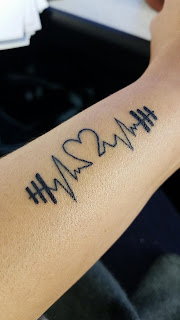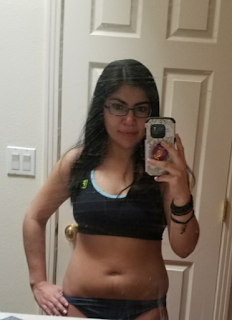Marathon time...but not running
Good evening everyone! I decided I am going to have a Harry Potter Marathon soon! I think it's time to re-watch the movies and re-read the books! Yay! I'm so excited. I'm thinking I will read one book a week (or more)! Starting this week! I'm really excited, even though I've seen the movies and watched the books many time, but I love Harry Potter so much! Once I finish the books (or before I finish them), Harry Potter Movie weekend time! Have you been playing Harry Potter Wizards United?!?! I have!!! I love it!!!! I am also so excited because I made my dad and older sister a training plan for a 10k! I am so excited that they want to keep running! I timed it so that when I run my marathon, they will be running their 10k! It'll be great! We are all going to be challenging ourselves and doubling our mileage which is incredibly daunting and difficult for all of us. It was also super fun to make. By 'make' I mean research training plans and combining a couple for the right length of time and adjusting them to incorporate exercises/classes they already do. It was fun!
Marathon Training Plan-Week 8-Half Marathon Specific Phase
Monday 6/17/19: Speed Work
2 mile Warm Up
4 x 1200m at 10k Pace with 2 minutes rest
2 mile Warm Down
Warm up and warm down pace was around an 8:50min/mile. 1200 meters is about 0.75 miles. 10k pace was ran at 7:05min/mile
Tuesday 6/18/19: OrangeTheory, Leg Day, and Barre
4 sets:
Leg Press Wide: 180lb, 235lb, 270lb, 270lb
Seated Leg Curl: 45lb
Leg Abductors: 80lb, 90,lb, 100lb, 100lb
Leg Extension: 100lb, 110lb, 120lb, 120lb
Leg Press Narrow: 180lb plus rack
Abs
Since my mileage is increasing, I am trying to to moderate to light weight. My trainer and I are just trying to see how I'm feeling while working legs. Even though what we have been doing is generally easy for me, I know I don't want to overwork my legs or place too much strain since I want to save my strength for my runs. Trying to find the balance of maintaining my current muscle strength while not overexerting myself is a process and learning experience. Even though I am taking it lighter, I don't want it to be too easy! Plus, I do teach Barre after. I do exert myself a little with that, but my focus is on my clients and getting them to push themselves!
For lunch today, I went to OrangeTheory! It was fun! I love it. Since Tuesdays and Thursdays aren't big calorie burning days, I wanted to try incorporating it. I love the environment, the coaches and staff are so welcoming and super nice. Plus, like I said last week, it's nice to change things up!
Wednesday 6/19/19: Aerobic Run
4-6 mile Aerobic Run
I ran 6 miles at a 10:00min/mile pace.
Thursday 6/20/19: OrangeTheory, Upper Body, and Barre
4 sets:
Lateral pull down wide neutral grip: 50lb, 60lb
Tricep push down tight grip: 40lb
Lateral pull down wide underhand grip wide: 50lb, 60lb
Tricep push down wide grip: 40lb
Lateral pull down underhand grip narrow: 50lb, 60lb
For all 4 sets, 12 reps were done for the lateral pull downs and 10 for the triceps pull downs. For the first two sets, 50lb was used for the lateral pull downs and the last two sets 60lb was used. For the tricep push down, 40lb was used for all 4 sets.
Friday 6/21/19: Tempo Run
1 mile easy
4 miles at HMP
1 mile easy
Easy pace was ran at 8:50min/mile and half marathon pace (HMP) was ran at 7:25min/mile.
Saturday 6/22/19: Long Run and Barre
60 minutes easy
8 x (2 minutes at 10k Pace/ 2 minutes at MP)
20 minutes easy
I ran the first 60 minutes at an easy pace of 8:50min/mile. I tried to run the 2 minutes at a 10k pace of 7:05min/mile and then 2 minutes at 7:45min/mile, but some of them were slower. The last 20 minutes were mostly at 8:50min/mile but some minutes were closer to an aerobic pace of 10min/mile. Total mileage ended up being 13.26 miles. I thought it went well, especially for missing my long run last weekend. After my run, I taught Barre class! It was my first Saturday class! It was great! I am super excited to start teaching it more!
Sunday 6/23/19: Rest!
I've been meaning to talk about determining calories, and I keep forgetting to mention it, but not today! Determining calories starts with determining your Basal Metabolic Rate (BMR). BMR is the rate of energy expenditure per unit time by endothermic animals at rest, so it is the number of calories required to keep your body functioning at rest. It is also known as your body's metabolism. BMR is based largely on involuntary functions such as breathing and pumping blood. Changes in your day-to-day activity don't do much to raise or lower this number. However, increasing muscle mass does increase BMR. This is because muscle is metabolically "hungry" and it takes more energy to maintain more muscle. When you increase your muscle mass, you'll burn more calories at rest. BMR calculations are also based on gender, height, weight, and age. I use different online BMR calculators and use the average. Once you know your BMR, you multiply by an activity factor to determine your daily calorie needs. Based on the Harris Benedict Formula the factors are:
If you are sedentary (little or no exercise): 1.2
If you are lightly active (light exercise/sports 1-3 days/week): 1.375
If you are moderately active (moderate exercise/sports 3-5 days/week): 1.55
If you are very active (hard exercise/sports 6-7 days a week): 1.725
If you are extra active (very hard exercise/sports & physical job or 2x training): 1.9
Once you determine your daily calorie needs, based on your goals (weight loss, weight gain, maintenance), you determine how much calories to add or subtract. For weight loss, subtract 500-1000 calories from your daily. For women, you don't want to go below 1200 (I think 1000 at the absolute minimum but 1200 is already low) and men, shouldn't go below 1800 (but definitely no less than 1200-1500). For weight gain, add 500 calories. For maintenance, it will just be the daily calorie needs.
Many online calculators and fitness apps already incorporate these calculations when you input your information and select what your goals are since most ask for your activity level and goals. I just thought it would be nice to share a bit of where those numbers come from. Also, apps like myfitnesspal do keep it at those minimums for weight loss I mentioned. If I've ever been below 1000 calories, it told me to eat more (not in those words, but just a message that I'm not eating enough and for healthy weight loss no less than 1000-1200 for women and 1200-1500 for men). Myfitnesspal also does not count exercise activity towards the calculation which is why it adds calories when you add exercises.
I have not been doing that great with hydration this week. I don't know why 😔 I will get back on top of it this week for sure. I am doing pretty decent meeting those macronutrient goals (40% C, 30% P, 30% F). I am not doing as well meeting my calorie goals 😅 I will definitely focus more on that. I think not drinking enough water contributed to that this week.
I am loving OrangeTheory! I have not done as well as my first class. I am thinking maybe monitor placement, or maybe I really just haven't been working as hard, or a combination of both. I failed to get 12 splat points (12 minutes in the orange and red zone) on Thursday, but I still burned calories and worked hard. For those who don't know, these are the zones:

Photo Credit to OrangeTheory and from they're website
Grey Zone (50-60% Maximum Heart Rate) – This is the safest, most comfortable zone, consisting of very light activity.
Blue Zone (61-70% Maximum Heart Rate) – This zone is specifically geared for warm up and cool down exercises. You are merely preparing your body and mind for high intensity interval training, but you haven’t unleashed the burn just yet.
Green Zone (71-83% Maximum Heart Rate) – In this zone, you have reached a challenging but doable pace. This is what Orangetheory categorizes as “Base Pace,” a pace that you can maintain for 20-30 total minutes. Your body starts to burn fat and carbohydrates evenly.
Orange Zone (84-91% Maximum Heart Rate) – This is where the magic happens and where you achieve “EPOC” (Excess post-exercise oxygen consumption) – what we call the “Orange Effect / Afterburn.” The goal is to accumulate 12 minutes or more in this zone within a 60-minute period to achieve the maximum caloric burn up to 36 hours AFTER your workout is completed.
Red Zone (92-100% Maximum Heart Rate) – This zone happens organically and may be achieved during ‘All Out’ efforts when you’re emptying the tank and using every ounce of energy left in your body. You don’t need to set an All Out pace for more than 1 minute at a time to experience maximum results.
Description of zones courtesy of OrangeTheory fitness website
Excess post-exercise oxygen consumption (EPOC) is a real thing. One thing to keep in mind though, it is not a lot of extra calorie burn. As always, in depends on the individual for how many calories are burned post-workout. EPOC can also increase that VO2 max in the long term, which improves overall endurance.
Honestly, my favorite thing about OrangeTheory is the variety and how it makes me push myself to try to get into the orange zone. Even if I don't get those 12 splat poits, I know I worked hard and still got a burn and had tons of fun (yes, fun)!
"Two things you are in total control of in life are your attitude ad your effort."-unknown
Let's keep up our efforts and be our own inspirations. We need to believe in ourselves and remember we are capable and strong. It gets hard, but we can do it. It is hard to keep a positive and determined attitude, but we need to remind ourselves and keep trying.
Lots of love,
💗Ari💚



Comments
Post a Comment